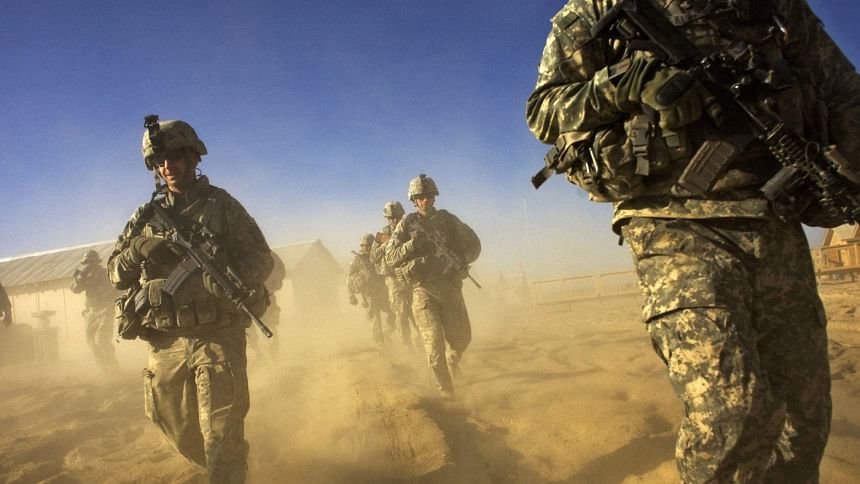From the graveyard of empires, the US retreats

Twenty-years after 9/11 and the invasion of Afghanistan by US and NATO forces, the US is on the cusp of withdrawing its forces from the proverbial "graveyard of empires", with the US military claiming its withdrawal is more than 90 percent complete. On July 1, US forces left the symbolic Bagram Airfield "by shutting off the electricity and slipping away in the night without notifying the base's new Afghan commander," the Sydney Morning Herald reported. The New York Times observed that the final withdrawal "occurred with little fanfare and no public ceremony, and in an atmosphere of grave concern over the Afghan security forces' ability to hold off Taliban advances across the country." Already, on July 1, the Taliban announced they controlled 80 percent of Afghan territory. That's close to the situation 20 years ago, only a few weeks before 9/11, when the Taliban controlled around 85 percent of the territory.
The end of the 20-year US war on Afghanistan was predictable. No one has conquered Afghanistan, and Washington was as foolish as Moscow was in the 1970s for trying. As the US rushes to pull out its troops, having just evacuated what has been the symbol of US occupation of Afghanistan for 20 years, many couldn't help but call it Washington's "Saigon moment 2.0". According to former US presidential candidate Ron Paul, "While perhaps not as dramatic as the 'Fall of Saigon' in 1975, where US military helicopters scrambled to evacuate personnel from the roof of the US Embassy, the lesson remains the same and remains unlearned: attempting to occupy, control, and remake a foreign country into Washington's image of the United States will never work."
That this lesson remains unlearned is evident in how the US media and the military have opposed the withdrawal. President Biden, however, has shown great resolve in keeping to his words and resisting the immense pressure put on him by the country's military-media-industrial complex. Supporters of prolonging the occupation argue that the Afghan government is not ready to withstand the Taliban offensive without foreign troop presence. They say there are a number of issues that need sorting before Afghanistan can regain some stability. Opponents of this position point to the obvious: if this couldn't be done in 20 years, then how can the US occupation help achieve this now?
The US is estimated to have spent nearly USD 100 billion in training the Afghan army and police force. The real number is likely several times higher. For all that money and 20 years of training, the Afghan army still cannot resist a full Taliban offensive. Earlier in April, Brown University's Cost of War Project calculated the total cost of the Afghan war at more than USD 2 trillion. That means, millions of Americans have been made poorer for this failed project, while thousands of the well-connected contractors and companies that lobby for war have become richer—that may explain the real reason for the opposition to the US withdrawal instead of a legitimate concern in Washington for the plight of Afghans once the US retreats.
While the US leaves Afghanistan red-faced, it still cannot admit fully that it has lost the war in Afghanistan. It has created more extremism than what existed before, and produced more terror than what the world witnessed on 9/11. As a result, according to former US intelligence officer and UN weapons inspector Scott Ritter, only someone who is "blind to reality could make a case that the US has degraded the terrorist threat emanating from Afghanistan."
Meanwhile, a cliff-hanger is set for the end of July, as the Taliban announced they will submit a written peace proposal to Kabul, which ultimately may amount to an intimation for the Afghan government in Kabul to surrender and transfer full control of the country. Consequently, the Taliban are fast advancing in western Vardak. If they get control of Vardak, they will literally be at the gates of Kabul. And they are also about to make a move on Hairaton, in Balkh province. Hairaton is at the Afghan-Uzbek border, the site of the historically important Friendship Bridge over the Amu Darya river, through which the Red Army departed Afghanistan in 1989. The symbolism of it all couldn't be more ironic.
So where does that leave the Afghan people and the government?
As far as the people are concerned, most are already afraid of what is to come. A full-blown civil war would be the worst outcome, and many see this as being a likely outcome. The Taliban are currently armed to the teeth, having "recovered" massive amounts of weaponry from abandoned US weapons caches. Ordinary Afghans, in order to have a say in their own future, are also arming themselves as much as possible, while militia groups are rising up.
The government, although currently negotiating with the Taliban, are yet to solidify any final agreement. According to Nader Nadery, a member of the Afghan government's peace negotiating team, it is clear that in the end, the Taliban cannot win in achieving all of their objectives. So there are two potential scenarios: (I) "A prolonged war that the Afghan defence and security forces will continue" if a peaceful settlement is not reached—which would strengthen different terror outfits in the country and the region; and II) "A peaceful settlement where the Taliban will agree to be a part of a structure" that defines a shared future for all sides in Afghanistan.
The best way to ensure that all parties to the conflict within Afghanistan choose option two is to involve all regional players in the negotiations. That includes India, Pakistan, China, Russia and Iran. None of these countries gain anything from having a volatile Afghanistan that threatens regional security and cooperation.
India has already tasted the bitter taste of extremism. China has been in close contact with the Taliban since early 2020, as it essentially wants to extend the USD 62 billion China-Pakistan Economic Corridor (CPEC)—one of the Belt and Road Initiative (BRI) flagship projects—to Afghanistan. The first crucial step will be the construction of the Kabul-Peshawar motorway, through the Khyber Pass and the current border at Torkham, which means Afghanistan de facto becoming part of CPEC. Therefore, its plan, clearly, is to dangle the carrot of economic benefits in front of both the Taliban and the Afghan government.
Russia is already concerned about the increased violence in northern Afghanistan, which borders former Soviet countries such as Tajikistan. Iran, on the other hand, definitely doesn't want Sunni extremist groups to increase in its border regions with Afghanistan.
And thus, all of these countries should look to join in the efforts to get the different warring parties in Afghanistan to find a peaceful, political settlement to the crisis. That is what the US should have tried to do a long time ago. In the end, while trying to turn Afghanistan into Soviet Union's Vietnam some 30-40 years ago and then going back and occupying the country, the US is now having to leave its own Vietnam 2.0, once more in defeat.
Eresh Omar Jamal is a member of the editorial team at The Daily Star. His Twitter handle is: @EreshOmarJamal

 For all latest news, follow The Daily Star's Google News channel.
For all latest news, follow The Daily Star's Google News channel. 



Comments